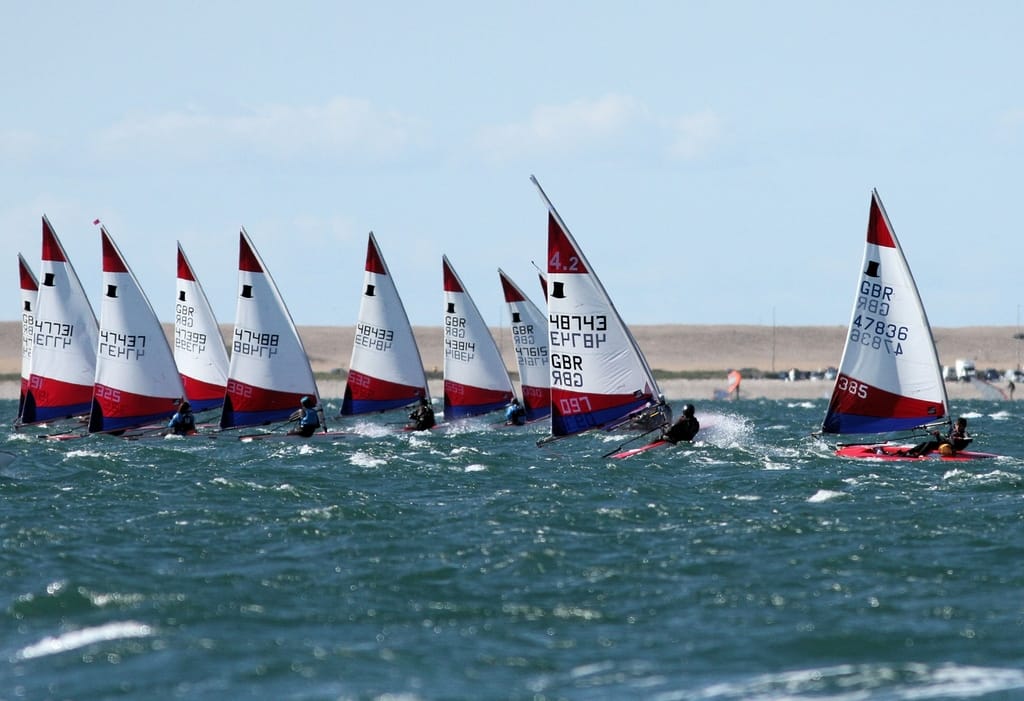Top Tips For Sailboat Racing
Most Cruising Sailboats are designed for comfortable sailing and living aboard. When informal racing becomes available, I find that some people pass on the opportunity because they feel their boat might not be suitable for competition. By using the following 13 ideas, sailors who occasionally enjoy racing can improve their performance and have more fun on the water.
Pre-Race:
Preparation before the race is time well spent. Read the sailing instructions carefully to understand the schedule, racecourse, and rules of the regatta. Next, recruit the correct number of crew for your boat. Sailing with too many or too few people makes it harder to perform efficiently. Next, study the weather so your team will have the correct clothing, set the most appropriate sails, and feel comfortable with the conditions you will sail in. Keep the boat light. Take off any items that you will not need for the race. Too much gear will slow the boat down. This may take a little time, but the boat will sail faster, and the extra room will make it easier for the crew to handle the sails and move around.
Before the race, hold a crew meeting. During this session, assign each member of the crew a specific job to do during key moments of the race, such as the start, rounding marks, changing sails, or maneuvering. This is the time to discuss the weather forecast, explain the racecourse, and set your goal for the day. Head out to the course at least one hour before the race. From the moment you leave the harbor, take the attitude that you are racing.
Sailboat Racing Start Tactics
Practice at least two starts. I like to try one practice start at each end of the line. Make a note of which end of the line seems to be favored (closer to the first mark of the course). Next, study the course to determine which side might have more wind. The best way to do this is to look at other boats. Ask yourself which boats appear to be heeling more or sailing faster. Every member of the crew should work in his or her pre-assigned area during practice. When you make the final approach to the starting line, avoid getting locked up with another boat.
Your goal is to start with full speed and clear wind. This is easier if you can start cleanly. Accelerate up to full speed at least 10 seconds before the gun. Most cruising boats are relatively heavy and take time to reach full speed. Ask one crew member to take bearings as you approach the line. You should be within one-half a boat length of the line at the start.

Tactics:
On the first leg, stay on the same course for two minutes or longer before making the first maneuver. When you prepare to tack, make sure the entire crew is ready. Watch carefully to make sure you will be sailing in the clear wind (clear of other boats) after the turn. If you think your boat is gaining by sailing straight ahead, keep going. If your side of the course seems to be losing distance to other boats, then you should consider switching sides of the course. Only tack when you have a reason; a big mistake many tacticians make is tacking too often.
Constantly study the wind. When reading the wind, wear polarized sunglasses to help cut the glare and make seeing the wind ripples easier. Use all available indicators to see what the wind is doing. This includes the course other boats are steering or how far they are heeling over, fags onshore, smoke from stacks, and the angle of anchored boats.
Maneuvering:
All boats lose considerable distance while tacking or jibing. Prepare your crew well in advance of any turn. But be careful not to shout too loudly; you don’t want the competition to know when you are about to tack. Sail at full speed before making your turn. Never turn the boat faster than the crew can trim the sails onto the new side. A tack should be broken up into three stages: the first third of a tack or jibe should be slow. The harder you turn the rudder, the more the boat will slow down.
The second part of the turn should be faster. This is when the wind is straight ahead during a tack and straight behind during a jibe. The last part of the turn should be slower while the sails full and your boat accelerates. Look at the course you have steered by studying the water behind your boat. If the shape of the turbulence in the water resembles the shape of a question mark, it is an indication that you have turned the boat too quickly.
Steering:
Skippers gain popularity with crews by allowing several people to steer during a race. While at the helm, concentrate on just steering. Use every source of information available. This list includes the speed and wind instruments, the angle of the heel of the boat, and the telltales flowing from the sails. If a big gust of wind is approaching, prepare to sail a higher course to keep the boat from heeling too much. Tell your mainsail trimmer to prepare to drop the traveler to leeward or ease the sheet out. Overheeling makes a boat go sidewise and lose speed.
The most skilled helmsmen work to keep their boats sailing fast by avoiding sailing a course that is too close to the wind and, therefore, slow. The best way to determine if you’re sailing efficiently is by studying your boat’s speed compared to the competition’s. This is the job of the tactician. Use a hand bearing compass to tell if you are gaining or losing bearing to another boat.
Speed:
Trim your sails to perfection. The maximum draft of all sails should be about 40 percent of the way aft of the leading edge. Sight up the mainsail’s boom — the top batten should be parallel to the boom. Try to set the leech of the jib to be in line with the curvature of the mainsail. If the jib is lufng at the top before the bottom, move the jib lead forward. If the jib is lufng at the bottom of the sail first, move the jib lead aft. Your goal is to have the telltales all lufng at the same time. If you fly a spinnaker, set the pole so that it’s perpendicular to the mast. Raise or lower the spinnaker pole, so the bottom corners (the clews) of the sail are in line with the horizon.
If the boat is heeling too much, fatten the shape of the main and jib. Anytime you take tension in a sail, the draft will move in that direction. If your boat is sailing in light wind and you’re sailing slowly, ease the sheet, downhaul, and halyard to give the sail a more curved shape. One crew should constantly trim the mainsail while another crew trims the jib or spinnaker. The helmsman and the trimmers should talk to each other. If the helmsman is heeling too much, he should ask to reduce the power in the sails by easing them out or fattening out the draft in the sail.

Know the Basic Racing Rules
The rules are complex and require years of practice or study to understand all the subtle nuances. But the fundamental rules are designed to keep boats from having collisions. If you’re on a starboard tack, your boat has the right-of-way. If you’re too leeward, your boat has the right-of-way. An overtaking boat must stay clear of a boat ahead. An inside boat approaching a turning mark is entitled to room to pass the mark. If you must alter course to stay Hands-On sailOr clear of a right-of-way boat, it helps to hail the other boat that you are changing course. The rules are based on common sense.
Sail in Clear Wind
The wind shadow of boats can extend as far as 10 boat lengths. Avoid sailing in the exhaust of another boat. Note the position of your masthead. If it points at another boat —whether on a windward leg or a leeward leg — the other boat is likely giving you disturbed wind. Your options are to tack or jibe away or sail a different course until your wind is clear.
Communications:
On every vessel there is one person in charge. All information must be funneled to the skipper. This is the person who will make the final decisions. Input from the crew is always helpful. The tactician should note a boat’s progress, making the calls relative to your boat; for example, “We are sailing 5 degrees higher.” I have been on boats where a skipper will yell more and more about less and less. Screaming is no fun. A calm, steady voice will give the crew confidence that the correct calls are being made. When you are giving commands, speak in the direction of the crew so they can hear you, use as few words as possible, and explain things in precise terms. For example, ask to ease the jib 4 inches or head up 5 degrees. avoid making vague, confusing comments such as “ease the jib a touch.”
Morale:
Keeping a crew happy is important. Everyone is on board to have a good time. As mentioned, yelling must be avoided at all costs. The tactician can build morale by forecasting what will happen in advance. An example might be, “We are going to tack in eight boat lengths. after the tack, we are going to sail five degrees low, of course, to gain speed for a bad set of waves that are approaching from a powerboat.” issuing team shirts or hats build team spirit. A well-fed crew is always happy. Be sure everyone is wearing the correct clothing, uses sunscreen, and most importantly, wears good shoes or boots. I have seen many injuries happen to barefoot sailors. When something goes well, be sure to compliment everyone.
Racing Philosophy:
Level of sailing, work to keep a good average score throughout a multiple-race regatta. Avoid taking big chances or splitting away from the fleet. One of the biggest mistakes is to get into a battle with just one other boat while allowing the rest of the fleet to sail away. When the wind is light, the skipper and crew need to be patient. Every member of the crew should be encouraged to add suggestions. The key is when to give advice. as a skipper, I like to ask questions about where the best wind seems to be or what actions other boats are taking. Don’t get too excited when you are in the lead and don’t get too upset when things go wrong. When behind, I tell my crew, “Just for fun, let’s see how much ground we can make up.”

Little Things Can Make a Big Difference
Many small adjustments add up. Keep your crew in the middle of the boat fore and aft. in light wind, move the crew to leeward. When the wind comes up and the boat heels over, move the crew to the windward side. During a race, I ask the crew to move frequently as the wind velocity changes. Watch the other boats. If you observe something going well on a competitor’s boat, use the idea.
After the Race
Afterward, take the time to have another crew meeting to discuss what went well and what can be done better for the next race. Make a list. If any equipment is broken or didn’t work well, get it fixed before the next race. Clean the boat up, fold sails, put the covers on, and put everything in its proper place before breaking out the snacks and drinks. Every member of the crew should participate. If your boat didn’t win, be sure to congratulate the winner. They will return the favor when things go your way. Always attend some part of the post-race festivities. The hosts appreciate your attendance. Finally, be sure to schedule your next race and invite the crew for another good time on the water.
